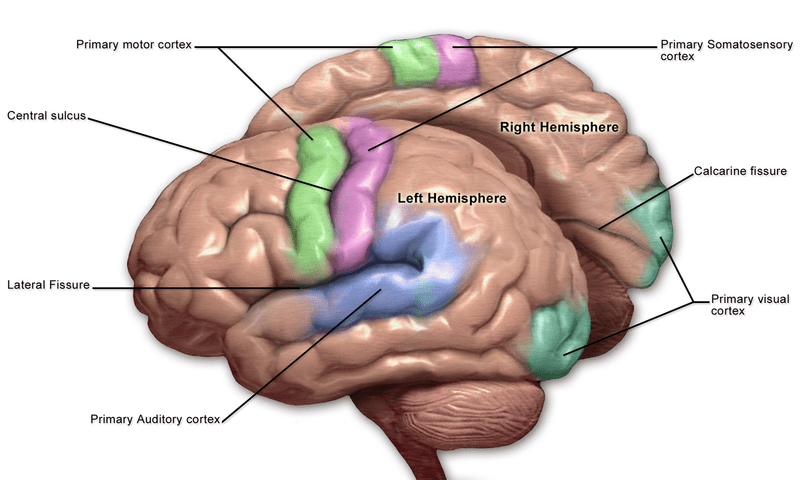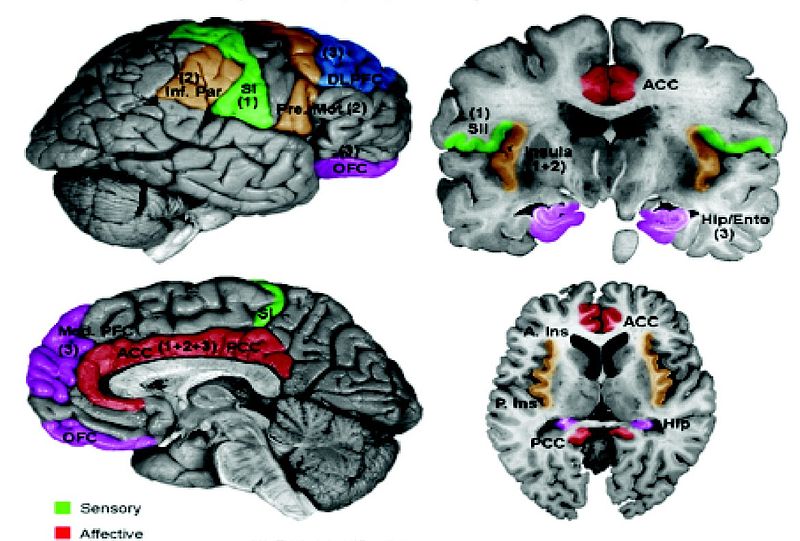The key difference between primary and secondary somatosensory cortex is that the primary somatosensory cortex is responsible for receiving and processing the sensory information coming from the somatic senses, proprioceptive senses, and some visceral senses, while the secondary somatosensory cortex is responsible for spatial and tactile memory associated with sensory experiences.
Somatic sensations originate when sensory receptors receive stimuli. Sensory receptors are mainly located in the skin, muscle, joints and tendons. The somatosensory cortex is the part of our brain that is responsible for receiving and processing sensory information coming from the somatic sensory system. There are three main parts of the somatosensory cortex. The primary somatosensory cortex and secondary somatosensory cortex are two of them. The primary somatosensory cortex receives peripheral sensory information while the secondary somatosensory cortex stores and processes them.
CONTENTS
1. Overview and Key Difference
2. What is Primary Somatosensory Cortex
3. What is Secondary Somatosensory Cortex
4. Similarities – Primary and Secondary Somatosensory Cortex
5. Primary vs Secondary Somatosensory Cortex in Tabular Form
6. Summary – Primary vs Secondary Somatosensory Cortex
What is Primary Somatosensory Cortex?
The primary somatosensory cortex is the area that receives sensory information from the somatic senses, proprioceptive senses, and visceral senses. This area is also known as S1, and it is located on the postcentral gyrus of the parietal lobe of the brain. Hence, the primary somatosensory cortex plays a vital role in processing afferent somatosensory information. Somatic sensations such as touch, pain, the position of the body, etc., are processed by the primary somatosensory cortex.

Figure 01: Primary Somatosensory Cortex
Structurally, the primary somatosensory cortex consists of Brodmann areas 1, 2, 3a, and 3b. Area 3 receives the bulk of the somatosensory inputs. The touch sensation is mainly processed by area 3b, while area 3a processes information from proprioceptors. Area 3b sends touch information to areas 1 and 2 for further processing. Area 1 is important for sensing the texture of an object. Area 2 is responsible for perceiving the size and shape of an object. It is also responsible for proprioception.
Neurological disorders occur due to abnormal processing of somatosensory information by the primary somatosensory cortex. Examples of such kinds of diseases are stroke, Parkinson’s disease, dystonia and ataxia.
What is Secondary Somatosensory Cortex?
The secondary somatosensory cortex is a part of the somatosensory system. It is also known as S2. It is located in the region of the parietal operculum in the upper part of the lateral sulcus. In fact, it is located posterior to the primary somatosensory cortex. Similar to the primary somatosensory cortex, the secondary somatosensory cortex is responsible for the processing of somatosensory information. It responds to somatosensory and visual stimuli. It is believed that S2 is involved in performing higher-order functions such as sensorimotor integration, integration of information from the two body halves, attention, learning and memory, etc.

Figure 02: Secondary Somatosensory Cortex
Structurally, S2 consists of two parts: Brodmann areas 40 and 43. However, little information is available about the structural organization and function of the human secondary somatosensory cortex in comparison to the primary somatosensory cortex.
Similarities Between Primary and Secondary Somatosensory Cortex
- The primary and secondary somatosensory cortex are two parts of the somatosensory system.
- The neurons of both areas are similar.
- Neurons in both areas respond to electrical stimulation with similar response magnitude.
- Both are located in the parietal lobe of the brain.
- They engage in coding somatosensory information in mammals.
Difference Between Primary and Secondary Somatosensory Cortex
The primary somatosensory cortex is the part of the somatosensory system that receives and processes sensory information such as touch, temperature, vibration, pressure, and pain coming across the body. Meanwhile, the secondary somatosensory cortex is the part of the somatosensory system that is responsible for spatial and tactile memory associated with sensory experiences. So, this is the key difference between primary and secondary somatosensory cortex.
Besides, the primary somatosensory cortex is also known as S1, while the secondary somatosensory cortex is known as S2. S2 is located in the postcentral gyrus of the parietal lobe whereas S2 is located posterior to the primary somatosensory cortex in the upper part of the lateral sulcus. Moreover, S1 consists of Brodmann areas 1, 2, 3a, and 3b, while S2 consists of Brodmann areas 40 and 43.
The following infographic lists the differences between primary and secondary somatosensory cortex in tabular form for side by side comparison.
Summary – Primary vs Secondary Somatosensory Cortex
Somatosensory consists of several cortical areas, including primary and secondary somatosensory cortex. The primary somatosensory cortex is responsible for receiving the bulk of somatosensory inputs, including touch, temperature, vibration, pressure, and pain, etc. Whereas, the secondary somatosensory cortex is associated with spatial and tactile memory associated with sensory experiences. Thus, this is the key difference between primary and secondary somatosensory cortex.
Reference:
1. Raju, Harsha. “Neuroanatomy, Somatosensory Cortex.” StatPearls [Internet]., U.S. National Library of Medicine, 19 Nov. 2020.
2. Ruben, J., et al. “Somatotopic Organization of Human Secondary Somatosensory Cortex.” OUP Academic, Oxford University Press, 1 May 2001.
Image Courtesy:
1. “Blausen 0103 Brain Sensory&Motor” By Blausen.com staff (2014). “Medical gallery of Blausen Medical 2014”;. WikiJournal of Medicine 1 (2). DOI:10.15347/wjm/2014.010. ISSN 2002-4436. – Own work (CC BY 3.0) via Commons Wikimedia
2. “Schematic of cortical areas involved with pain processing and fMRI cropped” By Borsook D, Moulton EA, Schmidt KF, Becerra LR.derivative work: Anthonyhcole (talk) – (CC BY 2.0) via Commons Wikimedia
ncG1vNJzZmivp6x7pbXFn5yrnZ6YsqOx07CcnqZemLyue9ahmK1lmah6tbTEZpuinpaav6a6wp5km52krLKmuoypqaKlkafGbq3NnWSsnZOku6Wt0bJkrKedlsGwv8SnqqiqqWKwsL7Tnq9o